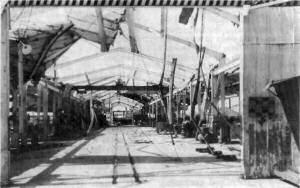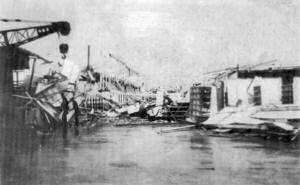Dressed in their Sunday best with cameras in hand, some 1100 troops of the U.S. Army and cabin class passengers lined the rail of the USNS Sultan November 13 as she pulled into Apra Harbor on what was to be for them liberty ashore after their long voyage from San Francisco.
Within twenty minutes after the ship was tied up, the troops were debarking in fatigues and boots to join special work details assigned to help the people of typhoon-devastated Guam in their program of mass recovery.
Mercy Missions
This was Guam's first good news from the Sultan, but far from the last. The ship and her personnel--crew, passengers and troops -- were involved in some 100 mercy missions and projects throughout the battered island, making the Sultan the most versatile ship of its kind in the Military Sea Transportation Service.
The ship is entirely self-sufficient at her pier. She was prepared and standing by to provide power and light to the waterfront and the Ship Repair Facility nearby.
Work With PWC
 TWO OF PWC'S buildings show the signs of having fought with Typhoon Karen and lost!
One of the sheet metal shop buildings (above) was completely gutted by the rain and wind of the
typhoon.
TWO OF PWC'S buildings show the signs of having fought with Typhoon Karen and lost!
One of the sheet metal shop buildings (above) was completely gutted by the rain and wind of the
typhoon.(ComNavMar Photo)
Better than 30 electricians and Diesel engineers went ashore daily to work nearly 'round the clock with the men of the Public Works Center alleviating the island's power shortage by energizing auxiliary Diesel plants. Since November 15, for example, to complete one job at Harmon Village, these men have returned to the ship as late as 3 a.m. for rest and a hot meal only to return to work at 6 a.m. the same day.
Having secured their circuits upon the Sultan's arrival, two radio operators aided the restoration of island-wide communications and stood evening watches as well.
Most Generous
The ship was most generous in supplying tools, lights and batteries to the Naval Hospital. And NCS has procured from her vitally needed spare parts and equipment.
Engineers, mechanics, burners and welders were highly instrumental in energizing the sewage system in Asan Village and helped tear down Harmon's piping system, rebuilding it for permanent use.
Other crewmen who normally take pride in their "sea legs" got their "tree legs" as part of the Navy's pole climbing team, restringing power lines across the entire breadth of the island. Each morning they debarked in their hip boots to forage through the hinterland with cable and equipment on their backs, subsisting on C-rations--all on a voluntary basis.
Miniature Hospital
The Sultan's medical team, headed by LT John Leissring. MC. USN, established a miniature hospital in the sick bay to accommodate the overload of patients, should there be one. His assistant LT Richard Warren MC, USN, took the evening duty in the obstetrics at the Naval Hospital since the ship's arrival and delivered 12 babies for Guamanian mothers.
Sick bay did the laundry and all sterilizing for the NavSta Dispensary while the corpsmen joined with other Navy and Marine medics to administer typhoid vaccine to Guamanians in all their 21 villages as part of the preventive medicine program.
Passengers on the Sultan proved a great boon to the recovery, too. Among them are Dr. and Mrs. (R.N.) Richard Morovitz who volunteered their services to Naval Hospital. Five nurse passengers and seven nurse's aides were also at the hospital giving relief to the regular staff and taking the many local cases, which greatly damaged Guam Memorial Hospital is unable to accommodate.
Guam welcomed the Sultan who saw her duty and did it, solving many of Guam's typhoon-attributed problems; and their good works, for which the island will always be grateful, continued throughout her stay.
PWC GETS OFF-ISLAND AID IN RECOVERY
CAPT Andrew S. Klay, CO PWC, said "three words come to mind as securing operations go underway--survival, recovery and restoration."
Surviving Karen's main blast, survey teams departed PWC's Command Post at 0200 November 12 to determine the extent of damages, particularly to power and communication lines. The sight was disconcerting as quick calculations revealed the damaged material far exceeded the supplies normally stocked. however, with the typical Navy "can do" spirit, military and civilians went to work, shoulder to shoulder to begin recovery operations.
Priorities were set to ensure that strategic areas of each command be operable as soon as possible. Generators were put into operation roads cleared of debris, Navy housing made water tight, heavy equipment dispatched to areas where needed and transportation provided for working crew.
Needed aid and supplies began arriving within three days to supplement the already tired work force and to boost their diminishing stocks of repair parts.
Personnel were sent from the following companies and Naval activities: Hawaiian Electric Co., Ltd.--40; Hawaiian Telephone Co.--31; PWC, Subic Bay--19; SRF. Subic Bay--4; PWC, Pearl Harbor--7; and Naval Shipyard, Pearl Harbor--14. These people have been engaged in stringing lines, cable splicing, and replacing or repairing poles in order to speed up utilities service to the entire island.
Thus recovery operations are well underway, and as life resumes some degree of normality, plans are being made for restoration.


